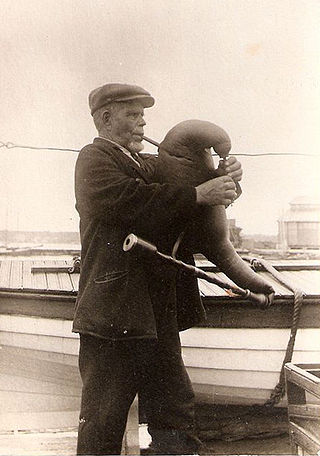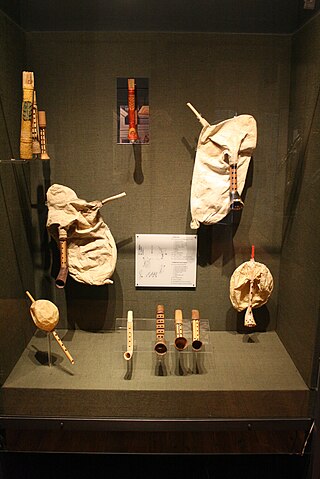Related Research Articles

Bagpipes are a woodwind instrument using enclosed reeds fed from a constant reservoir of air in the form of a bag. The Great Highland bagpipes are well known, but people have played bagpipes for centuries throughout large parts of Europe, Northern Africa, Western Asia, around the Persian Gulf and northern parts of South Asia.

The Great Highland bagpipe is a type of bagpipe native to Scotland, and the Scottish analogue to the Great Irish Warpipes. It has acquired widespread recognition through its usage in the British military and in pipe bands throughout the world.
The recorded history of music in Estonia dates back as far as the 12th century.

The Bladder pipe is a medieval simplified bagpipe, consisting of an insufflation tube, a bladder (bag) and a chanter; sounded by a double reed, which is fitted into a reed seat at the top of the chanter. The reed, inside the inflated bladder, is sounded continuously, and cannot be tongued. Some bladder pipes were made with a single drone pipe, and reproductions are similar to a loud, continuous crumhorn. The chanter has an outside tenon, at the top, near the reed, which fits into a socket or stock, which is then tied into the bladder.

Welsh bagpipes The names in Welsh refer specifically to a bagpipe. A related instrument is one type of bagpipe chanter, which when played without the bag and drone is called a pibgorn (English:hornpipe). The generic term pibau (pipes) which covers all woodwind instruments is also used. They have been played, documented, represented and described in Wales since the fourteenth century. A piper in Welsh is called a pibydd or a pibgodwr.

The torupill is a traditional bagpipe from Estonia.

The Associação Gaita-de-fole is a non-profit organization, founded officially in 1994 by enthusiasts of the Portuguese folk traditions — specially the related with the Transmontan and Galician bagpipes. The volunteers contribute in a variety of ways, as artisans, musicians, anthropologists and teachers, both professional and amateurs.

The xeremia is a type of bagpipe native to the island of Majorca (Mallorca). It consists of a bag made of skin, known as a sac or sarró which retains the air, a blowpipe (bufador), a melody pipe or chanter (grall), and several, generally three, drones (bordons). The primary drone (roncó) sounds a tonic note, but the other drones are sometimes simply false drones for ornamentation.

Dūdas or somas stabules is a type of bagpipe native to Latvia, popular from the 16th to 18th centuries.
Säkkipilli is the generic Finnish term for bagpipes, but is also applied to the formerly extinct traditional Finnish bagpipes which are currently being revived.

Estonian Maritime Academy of Tallinn University of Technology is a vocational university in Estonia. It is one of the schools of Tallinn University of Technology and it is the only educational institution in Estonia that offers professional higher education and Master’s level education in the maritime field. The university is located in the capital Tallinn but also has two centres in Saaremaa. In addition to higher education, the school contributes to research, provides training and offers services. The Academy also holds a one of a kind Simulator Centre and has a whole dedicated floor of hi-tech laboratories.

Äio is a release from Estonian folk metal band Metsatöll, released worldwide in 2010 on Spinefarm Records. It features heavy use of traditional instruments such as the lokulaud, torupill, kannel, and angipill, in addition to the typical metal band instrumentation
The mashak is a type of bagpipe found in Northern India, Uttarakhand, Sudurpaschim Province of Nepal and parts of Pakistan and Afghanistan. The pipe was associated with weddings and festive occasions. In India it is historically found in Garhwal (kumaon) in Uttarakhand, Rajasthan and Uttar Pradesh. This bagpipe uses single reeds, and can be played either as a drone or as a melody instrument.
Ants Taul is an Estonian musician and instrument-maker who played a prominent role in the revival of the Estonian bagpipe, the torupill. As early as 1976, Taul was recognised as one of Estonia's primary bagpipers, with piper Olev Roomet having retired due to ill health.
Aleksander Maaker, nicknamed Torupilli-Sass was a folk musician, a player of the traditional torupill, the Estonian bagpipe. Maaker was from the Estonian island of Hiiumaa. At the time of his death, the only other torupill player was the revivalist Olev Roomet, at the time a choir member, though other revivalist such as Ants Taul took up the instrument and its construction beginning in the 1970s.

Juhan Maaker nicknamed Torupilli-Juss was an Estonian folk musician, a player of the Estonian bagpipe. He was considered one of the most popular players at the time called the king of bagpipe players.
Olev may refer to:

The tsampouna is a Greek musical instrument and part of the bagpipe family. It is a double-chantered bagpipe, with no drone, and is inflated by blowing by mouth into a goatskin bag. The instrument is widespread in the Greek islands. The word is a reborrowing of zampogna, the word for the Italian double chantered pipes. Tsampouna is etymologically related to the Greek sumfōnia, meaning "concord or unison of sound" and applied later to a type of bagpipe.

Trad.Attack! is an Estonian band. The band consists of Sandra Vabarna, Jalmar Vabarna, and Tõnu Tubli. They sing in Estonian or Estonian dialects.
References
- ↑ "birthdays". tele2. Retrieved 16 May 2011.
- ↑ "varia". Sirp ja Vasar. Retrieved 16 May 2011.
- ↑ "Sünnipäevad: 20. OKTOOBER" (in Estonian). tele2.ee. Archived from the original on 22 July 2011. Retrieved 17 May 2011.
- 1 2 Conservatoire royal de musique de Bruxelles. Musée instrumental; Tõnurist, Igor (1976). "THE ESTONIAN BAGPIPE". Brussels Museum of Musical Instruments bulletin. F. Knuf. p. 53. Retrieved 16 May 2011.